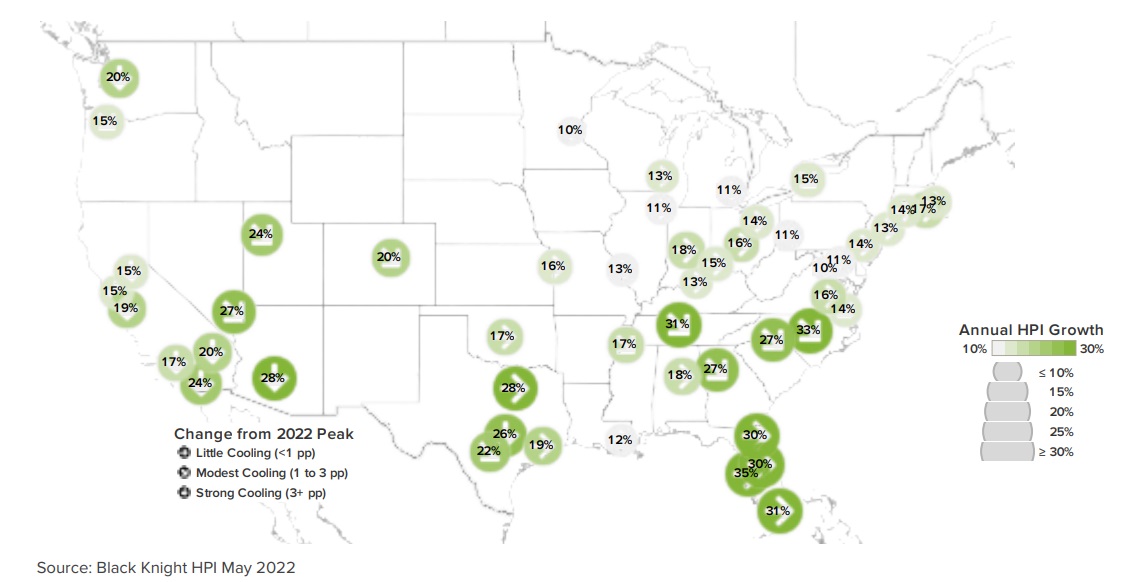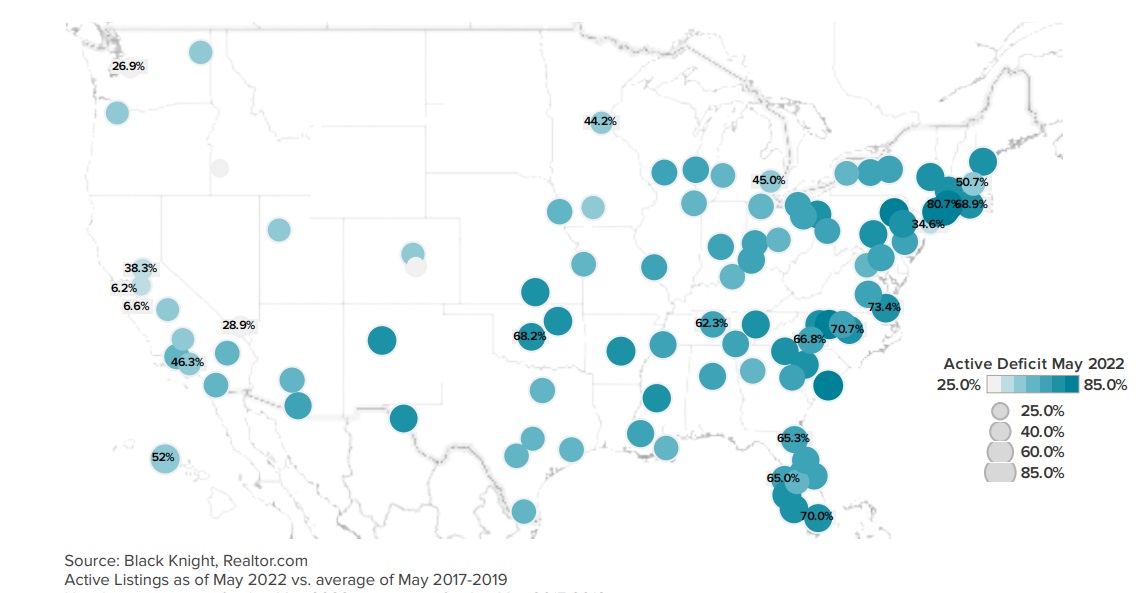In a shifting real estate market, the guidance and expertise that Inman imparts are never more valuable. Whether at our events, or with our daily news coverage and how-to journalism, we’re here to help you build your business, adopt the right tools — and make money. Join us in person in Las Vegas at Connect, and utilize your Select subscription for all the information you need to make the right decisions. When the waters get choppy, trust Inman to help you navigate.
Home price appreciation decelerated in May at rates not seen since 2006 as inventory shortages eased in many of the nation’s biggest housing markets. But affordability remains a challenge for many homebuyers, and only a handful of cities have seen actual price declines, according to data released Wednesday by Black Knight.
The Black Knight Home Price Index showed annual home price appreciation fell to 19.3 percent in May, down from 20.4 percent in April, with home price growth slowing down in 97 of the 100 largest U.S. housing markets. Miami, Omaha and Grand Rapids were the only exceptions.
Ben Graboske
“The annual home price growth rate fell by more than a full percentage point in May, the largest monthly decline at the national level since 2006,” said Black Knight Data & Analytics President Ben Graboske, in a statement. “However, even with growth slowing in 97 of the top 100 U.S. markets, overall home prices still rose 1.5 percent from April – nearly twice the historical average for the month of May.”
Annual home price appreciation in top 50 U.S. markets

At the current rate of deceleration, it would take more than 12 months for annual home price appreciation to come back down to historic norms of 3 to 5 percent.
“That said, the pace of deceleration could very well increase in the coming months, as we’ve already begun to see in select markets such as Austin, Boise and Phoenix,” Graboske said.
Markets that saw the most abrupt home price deceleration in May included Austin, (-12.2 percentage points), Boise (-12.1), Spokane, (-7.1), Stockton (-6), Phoenix (-5.1) and Seattle (-5).
Despite the slowdowns, price growth remains strong for now, and almost all major markets are continuing to see upward movement, Black Knight said.
Markets with highest home price appreciation
- Tampa (34.6 percent)
- Raleigh (33.0 percent)
- Nashville (31.3 percent)
- Miami (30.8 percent)
- Jacksonville (29.8 percent)
- Orlando (29.7 percent)
- Phoenix (27.9 percent)
- Dallas (27.8 percent)
- Atlanta (27.1 percent)
- Las Vegas (27.1 percent)
Markets with lowest home price appreciation
- Washington, D.C. (9.9 percent)
- Minneapolis (10.5 percent)
- Pittsburgh (10.9 percent)
- Baltimore (11.0 percent)
- Detroit (11.0 percent)
- Chicago (11.3 percent)
- New Orleans (11.9 percent)
- St. Louis (12.5 percent)
- Milwaukee (13.0 percent)
- Louisville (13.0 percent)
Only a handful of markets have seen prices come off their peaks, and “the pullbacks at this point have been marginal,” Black Knight analysts said in their monthly Mortgage Monitor report. “San Jose, California, has seen the sharpest pullback and even that has been modest, with the average price dropping by 0.5 percent in recent months.”
Affordability challenges
With rates on 30-year fixed-rate mortgages hovering at close to 6 percent and home prices up 44 percent since the start of the pandemic, homes are less affordable then they’ve been since the mid 1980s, when mortgage rates soared into the double digits.
A homebuyer purchasing the average-priced home with 20 percent down can now expect their monthly mortgage payment to exceed $2,100, nearly twice the $1,089 required at the beginning of the pandemic.
As of mid-June 2022, Black Knight calculates that the mortgage payment on the average home eats up 36.2 percent of median household income, surpassing the post-1980s peak of 34.1 percent seen in July 2006.
The payment-to-income ratio is even more extreme in markets like Los Angeles (73.3 percent), San Jose (67.8 percent), Las Vegas (54.7 percent) and Seattle (50.5 percent).
Home price appreciation is slowing in markets where affordability is particularly challenging, but also in markets where more listings are starting to come online.
Falling sales boost inventory
May saw the largest single-month increase in inventory in more than five years, with active listings rising by 107,000, nearly double the traditional seasonal rise for the month.
Rising inventory won’t necessarily translate into more sales, as “the improvements we’re seeing are due to falling sales volumes rather than an increase in listings, which isn’t good for transactional revenue,” Black Knight said.
The active listings deficit — the number of homes on the market in May 2022, compared to the 2017-19 average — decreased from -67 percent to -60 percent from April to May. But there were still about 769,000 fewer active listings on the market compared to historic norms, with all major markets still facing inventory deficits.
Listing deficits in top 50 U.S. markets

Markets with largest active listing deficits
- Hartford, Connecticut (81 percent)
- Virginia Beach (73 percent)
- Raleigh (71 percent)
- Miami (70 percent)
- Providence (69 percent)
- Oklahoma City (68 percent)
- Richmond (67 percent)
- Baltimore (67 percent)
- Cincinnati (67 percent)
- Baltimore (67 percent)
Markets with smallest active listing deficits
- San Francisco (6 percent)
- San Jose (7 percent)
- Seattle (27 percent)
- Las Vegas (29 percent)
- New York-Newark (35 percent)
- Sacramento (38 percent)
- Minneapolis (44 percent)
- Detroit (45 percent)
- Los Angeles (46 percent)
- Portland, Oregon (47 percent)
Markets like San Francisco, San Jose and Seattle are seeing the smallest listing deficits as affordability pressures and the ability to work remotely are leading homebuyers to look elsewhere, the report said.
At the beginning of the year, San Francisco had a 32 percent inventory deficit, which is now down to 6 percent, while San Jose’s inventory deficit has dropped from 50 percent to 7 percent. Seattle has also seen a dramatic improvement, starting the year with a 68 percent inventory deficit that’s dwindled to 27 percent.
“Given how quickly deficits are disappearing on the West Coast, those markets will be worth watching in coming months to see how prices react to a more balanced supply and demand,” the report said.
Email Matt Carter



 Are You Interested in West Eleventh Residences Miami?
Are You Interested in West Eleventh Residences Miami? Are You Interested in ONE Park Tower by Turnberry?
Are You Interested in ONE Park Tower by Turnberry? Are You Interested in Diesel Wynwood Condominium?
Are You Interested in Diesel Wynwood Condominium? Are You Interested in Five Park Miami Beach?
Are You Interested in Five Park Miami Beach? Are You Interested in Cipriani Residences Miami?
Are You Interested in Cipriani Residences Miami? Are You Interested in Bentley Residences Miami?
Are You Interested in Bentley Residences Miami? Are You Interested in Baccarat Residences Brickell?
Are You Interested in Baccarat Residences Brickell? Are You Interested in Aria Reserve Miami?
Are You Interested in Aria Reserve Miami? Are You Interested in 888 Brickell Dolce & Gabbana | Miami?
Are You Interested in 888 Brickell Dolce & Gabbana | Miami? Are You Interested in 600 Miami WorldCenter?
Are You Interested in 600 Miami WorldCenter? Are You Interested in HUB MIAMI RESIDENCES?
Are You Interested in HUB MIAMI RESIDENCES? Are You Interested in WALDORF ASTORIA RESIDENCES?
Are You Interested in WALDORF ASTORIA RESIDENCES?